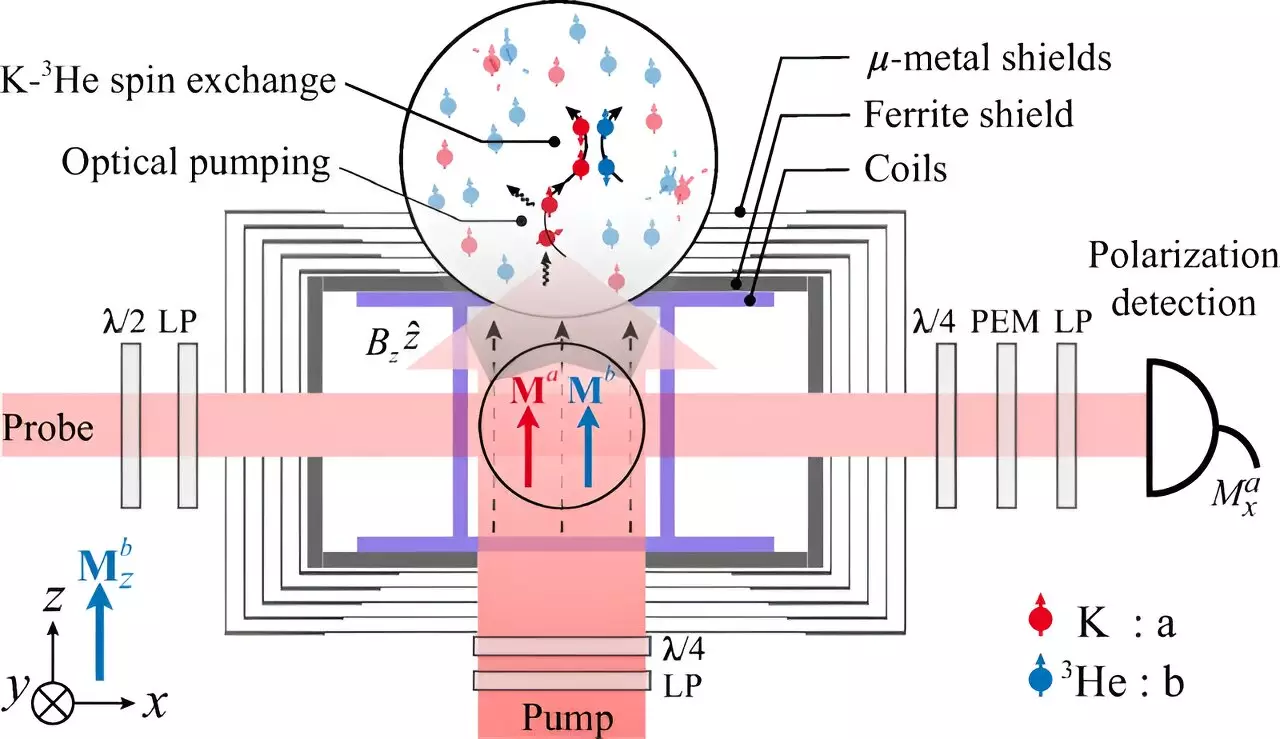In recent advancements within the field of precision measurement, researchers have explored unique phenomena, one of which is the Fano resonance interference effect observed among mixed atomic spins. This groundbreaking discovery, spearheaded by a research team at the University of Science and Technology of China (USTC), offers promising implications for enhancing measurement techniques against magnetic noise interference. The direct consequence of their findings, as detailed in their publication in Physical Review Letters, is the development of a sophisticated method that effectively reduces magnetic noise interference by at least two orders of magnitude, thus paving the way for more accurate experimental searches for exotic spin interactions.
The intrigue surrounding exotic spin interactions, which extend beyond the conventional framework of particle physics, has captured significant attention in the scientific community. These interactions are pivotal in high-stakes experiments that seek to uncover elusive phenomena such as spin-dark matter particle interactions and the hypothesized fifth force of nature. In these scientific inquiries, the ability to detect magnetic fields acting on atomic spins is crucial. Historically, measuring these exceptionally weak magnetic field signals has been plagued with challenges due to interference from background noise, particularly magnetic noise, thus complicating the quest to explore the wide landscape of exotic spin behaviors.
Traditional atomic comagnetometers, relied upon for mitigating magnetic noise, exhibited effectiveness primarily at low-frequency ranges (below 1Hz). This limitation has proved detrimental in the relentless search for new exotic spin interactions, hindering the ability of researchers to make significant progress in less-charted scientific territories. The saturation of existing methodologies has compelled researchers to innovate further, ensuring the precision required to probe deeper into realms still observed only theoretically.
In an impressive showcase of scientific ingenuity, the USTC research team has proposed a method for magnetic noise suppression that leverages the self-compensation effects of magnetic noise. The experimental framework incorporated a mixed system of potassium (K) and helium-3 (3He) gases, with K atoms polarized by laser technology engaging in spin-exchange collisions. This intricate setup allowed the nuclear spins of 3He to be effectively manipulated, with K atoms serving a dual purpose: polarization and readout.
By adopting a carefully balanced bias magnetic field, the researchers were able to fine-tune the polarization dynamics, enabling the nuclear spins of helium to adapt to and mitigate external low-frequency magnetic noise. This method marked a significant leap towards achieving controlled suppression of higher frequency magnetic disturbances, overcoming a critical barrier in prior technologies.
Theoretical Underpinnings and Experimental Validation
What sets this research apart is not merely the empirical findings but also the novel theoretical framework it proposes. The connection drawn to Fabry-Perot resonance interference enables a systematic understanding of how the described suppression occurs. Through meticulous adjustment of the detection angle concerning the frequency of the noise, researchers have managed to document a profound suppression effect spanning magnetic noise frequencies up to 200Hz, with suppression levels consistently recorded at over two orders of magnitude.
Additionally, the implications of this research extend beyond immediate applications. The insights gained suggest that enhancing the sensitivity of magnetic detection could lead to a significant leap in probing pseudomagnetic fields, presenting opportunities for detecting environmental phenomena such as dark matter and facilitating deeper explorations in fundamental physics research.
The implications of this study resonate far beyond the immediate technological advancements in noise suppression techniques. As scientific inquiry into dark matter and exotic interactions continues to burgeon, the research holds transformative potential in providing clarity within a significantly obscure area of study. The prospects for further enhancing the sensitivity of detection methodologies could potentially result in groundbreaking discoveries, opening new avenues for research that were previously deemed unattainable.
The innovative techniques outlined by this research team not only signify a substantial technological advance in the context of magnetic noise suppression but also underscore the exciting potential that exists at the intersection of fundamental physics and experimental measurement. By pushing the boundaries of scientific inquiry, the insights from this research may well redefine how we explore the universe’s most elusive aspects.

